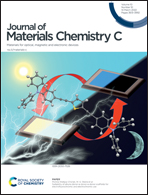Origin of the concentration-dependent effects of N on the stability and electrical resistivity in polycrystalline Ge1Sb2Te4†
Abstract
N (nitrogen) doping has been widely employed to optimize the overall performance of Ge–Sb–Te (GST) compounds, yet the microscopic doping effects in the presence of the grain boundary which is ubiquitous in crystalline GST remain unclear. In this work, using polycrystalline Ge1Sb2Te4 as an example, we present the underlying mechanism of the doping effects of N especially its concentration-dependent behavior using ab initio calculations. Our results show that at doping concentrations of over 3.45 at%, N will exist in the forms of a nitride complex and a nitrogen molecule, and the nitrogen molecule tends to segregate at the grain boundary over a critical doping concentration (∼4.55 at%). Accordingly, at the electronic scale, the nitride complex at low doping concentrations directly modifies the electronic structure near the Fermi level, reducing the electronic states near the Fermi level and opening a pseudo band gap, while the N2 molecule at a doping concentration of over 3.45 at% affects the electronic structure indirectly by tuning the bonding between the host matrix atoms. The distortions introduced by the grain boundaries and the intrinsic Peierls-like distortion in the crystalline phase can be suppressed by N, which gives rise to enhanced cyclability for the PCM cell. Moreover, a reduced hole concentration and more localized electron states introduced by the nitrogen dopants are directly observed, accounting for the increased electrical resistivity of crystalline Ge1Sb2Te4. Our work presents a fundamental understanding of doping effects of N in polycrystalline GST phase change materials.



 Please wait while we load your content...
Please wait while we load your content...